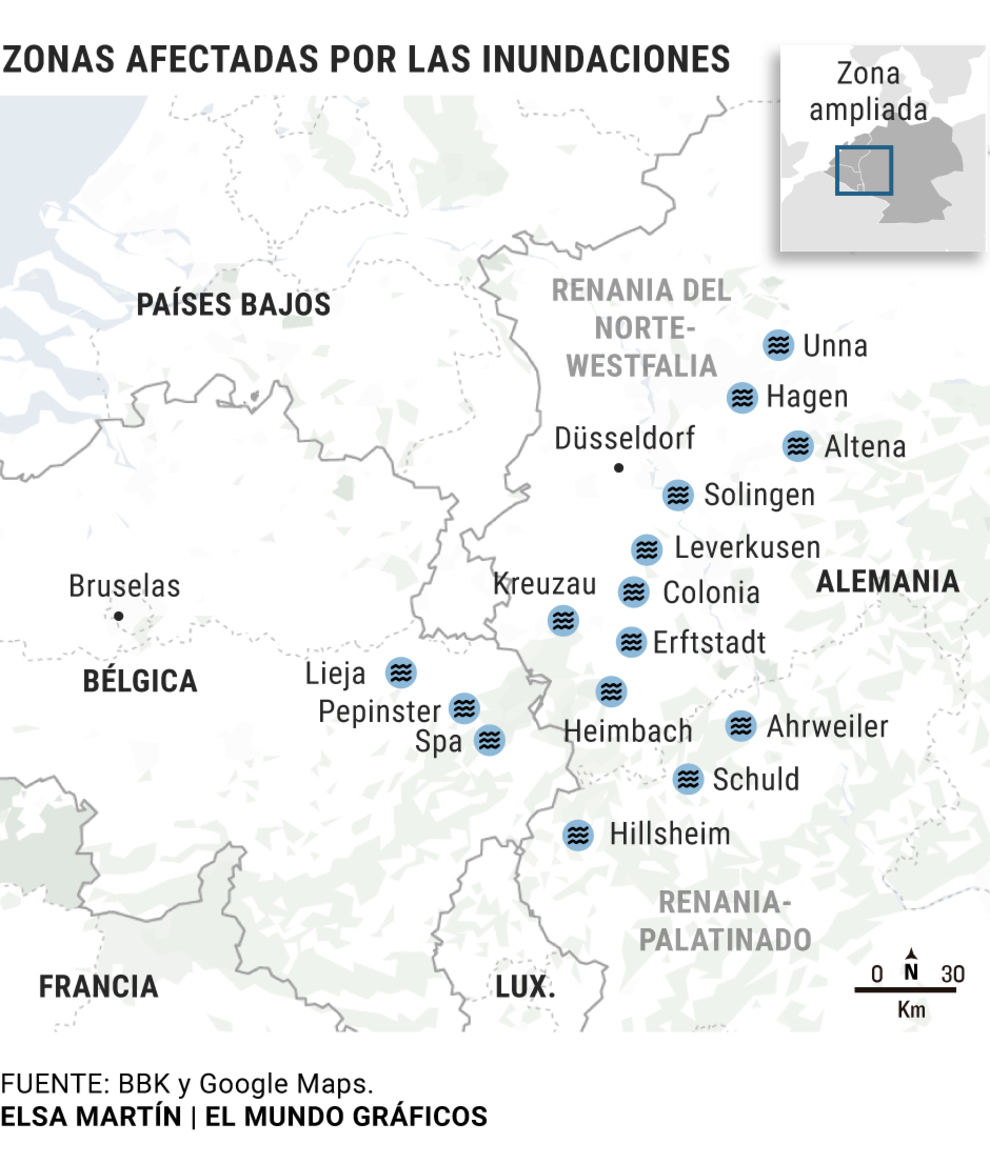Catastrophe in Germany "We search for missing persons and try to save dams and houses. We take people out in boats"
Europe Belgium also suffers from the rains: more than 20 dead, 30 missing and villages razed
As the waters recede in the flooded regions in western Germany, the death toll and the importance of the damage caused by storms that discharged more than 200 liters per square meter rises.
There are already 103 fatalities:
63 in Rhineland-Palatinate and 43 in North Rhine-Westphalia, the two federal states battered by nature. The number of missing is confusing, but it is several hundred and the damage to housing and public infrastructure unquantifiable.
"This has all been a monumental failure of the system,"
says Hannah Cloke, a British hydrologist and adviser to the European Alarm Service (EFAS). According to Cloke,
EFAS sent its German partners an "extreme" flood alert earlier in the week. "I could have expected an evacuation, but never such a high number of deaths and disappearances due to floods in 2021. This is very serious," he
declared to the
political
environment
.
In Germany, the time has not come to seek responsibilities -if there were any-, but rather to advance the rescue tasks looking to the future.
"We are going to raise every bridge, every railway section and every wrecked road and we will do it urgently,"
the minister-president of North Rhine-Westphalia, Armin Laschet, has promised. There is no estimate of damage, but it is so obvious to the naked eye that Laschet and his Rhineland-Palatinate colleague
Malu Drayer
have promised immediate, non-bureaucratic aid to mitigate the effects of a tragedy of historic proportions. Chancellor
Angela Merkel
, who was surprised by the catastrophe by flying to the United States, promised aid from Washington and this Friday the head of state did the same,
Frank-Walter Steinmeier
.
In your case with the warning that what is promised is a debt.
"We cannot create frustration for the victims by announcing aid if it does not materialize later," he declared.
The only announcement made so far from public administrations has been the 50 million euros that Drayer has released as emergency aid.
From the private sector, the German football federation has announced
a fund for the victims of three million euros
, the chemical consortium BASG will donate one million euros, and the archdiocese of Cologne 100,000 euros.
The Bonn city council, on the other hand, has offered a
thousand shelters for people who have been left homeless.
The numbers will start to dance when Merkel, who is already back in Berlin, takes charge of the situation. The Government spokesman,
Steffen Seibert,
has advanced that the Chancellor will travel shortly to the affected areas, after which a damage estimate will be made with Laschet, Drayer and their Finance Minister to release the relevant funds or initiate a process of aid to the European Union.
It is not premature to speak of reconstruction in the middle of rescue efforts. It is a breath of hope for the victims. In each image of the disaster areas captured by satellites and drones that fly over the area and then distributed to televisions,
the devastation and heartbreak of those who have lost their families, their homes and their way of life is palpable
. There are small towns of which only rubble remains, that of the houses torn from their foundations by the force of the water.
The affected municipalities have been declared catastrophic zones and the Defense Ministry has decreed the military alarm to facilitate the work of the nearly
900 soldiers who have been deployed in the area to accelerate relief
and clean-
up tasks
.
This alarm allows the commanders on the ground to work autonomously, define their operation and include the necessary equipment, including heavy vehicles.
In North Rhine-Westphalia, floods have seriously affected 23 municipalities, according to the Federal Civil Protection Service (BBK).
In Rhineland-Palatinate, the epicenter of the disaster is in the Aherweiler district.
One of its villages, with 700 inhabitants, has been practically destroyed, and half of its neighbors with injuries of varying degrees.
All these areas have been practically cordoned off to keep the civil protection services clear, including the
half thousand mobilized firefighters and health workers
.
Until late Friday there were a hundred ambulances in service.
In addition to road traffic, the river has been cut, at least until next week.
The railway was disabled by the floods.
In North Rhine-Westphalia alone, the most populous state in Germany,
the unstoppable body of water swallowed up nearly 600 kilometers of short and long-distance roads
, including stations, signs and reservoirs.
Added to this is the lack of electricity in the affected areas and cuts in communications due to the demolition of repeaters.
Although the situation tends to stabilize, in many regions it is still critical, especially in Euskirchen (North Rhine-Westphalia) and where the Steinbach dam is located.
According to the engineers who have traveled there to verify its resistance,
the dam has cracks and is consequently "very unstable"
.
In anticipation of a rupture, some 4,500 people residing in the area have been evacuated.
The only good news of a day with emotions running high is that the meteorological services do not expect heavy rains in the coming days.
According to the criteria of The Trust Project
Know more
Angela Merkel
Berlin
European Union
Germany
European UnionThe lowest hours of Angela Merkel in Brussels
North AfricaUnited States Involved in Libya and UN Announces Sending Ceasefire Observers
The Recovery Race (II) From rescuing them to debating the sale of key companies: Germany is already safe
See links of interest
Last News
Olympic Games
Work calendar
Home THE WORLD TODAY
Data journalism
Tour de France: stage 19, live: Mourenxs - Libourne

